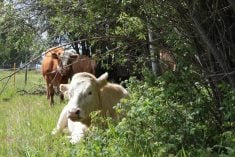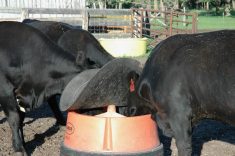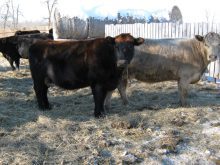Recently, I drove some back roads and took a picture of a herd of Black Angus cattle with a few of the cows and calves with a rough red hair coat or a red sheen to them. I was always taught in school that a red coat colour was a classic sign of a copper deficiency.
Whether, any of these cattle suffer from poor copper status or something else like a sunburn is hard to say, yet an actual copper deficiency might explain several incidences of poor health and inadequate vaccination in many spring calves some producers have expressed to me since the calving season, ending months ago. It is important to make sure spring calves (and cows) are fed a good beef mineral (and vitamins) program in order to build a good mineral status for better immunity against disease.
Read Also

Harvest wraps up and fall work begins
At the Eppich famly ranch in western Saskatchewan, the fall harvest was successful with few breakdowns, cows and calves have been sorted and a new tractor has arrived
A good mineral status primarily underlies all weaning and preconditioning programs coming up this fall and winter. A deficiency of one or more essential trace minerals in pre-weaned calves derails otherwise good immune function. This phenomenon occurs even before calf growth is affected and well before any visible signs such as a red coats on black calves appear. Furthermore, much of this impending damage to their immunity is often hidden, where calves may not reveal anything is wrong with their health and/or performance at the moment.
For example, a Colorado study showed about one-third of preconditioned calves receiving vaccinations as part of their prime saleability were still getting sick immediately after they were shipped to feedlots. The researchers speculated such morbidity was due to poor mineral supplementation starting with their originating cow-calf herds.
I draw my own similar conclusions — these calves had poor “vaccination take” (antibody titers) against disease, because under normal mineral supplementation; essential minerals work “behind the scenes” where normal immune function/response is triggered either by an invading disease or by vaccination. One scientific theory suggest such essential trace minerals act as “on/off switches” in metabolic enzymes driving biochemical reactions working within the immune system. Specifically, a good balanced pre-weaned or pre-conditioned diet should contain adequate levels of biologically available copper, zinc and selenium, which leads to good health.
Oddly enough, copper, zinc or selenium deficiencies are the only major evidence scientists have to verify that dietary levels of these trace minerals play a critical role in the immune function of cattle.
Examples include:
- Copper deficiency — Decrease in the number of white blood cells: mature phagocytic cells; neutrophils and macrophages. Reduction of T-lymphocytes and T-helper cells. Pronounced negative effect upon internal organs involved in immunity such as enlarged spleen and small thymus.
- Zinc deficiency — Atrophy of the thymus, reduction of T-cells production in antibody production and reduced immune cell maturity. Reduction in the production of immunoglobulins. Poor vaccination “take” in cattle.
- Selenium (and Vitamin E) deficiency — reduction in the number and reduce activity of white blood cells stimulated by disease. Reduced antibody titres in vaccinated cattle. Poor white blood cell integrity.
Luckily, there still is time to build up spring calves’ mineral status off copper, zinc, and selenium (and vitamin E), before they are weaned and some of these animals are moved onto further pre-conditioning and vaccination programs. I recommend feeding a commercial cattle mineral at the rate of 70 to 112 g per head per day (three to four ounces), either fed loose (accessible also to the cows) or mixed into an available calf creep diet.
The actual formulation of such a well-balanced cattle mineral should first contain complimentary levels (to forages, grains and other feedstuffs) of macro-minerals such as calcium, phosphorus, salt (sodium chloride), magnesium and potassium. Then, it should contain adequate levels of copper, zinc, manganese, cobalt, iodine and selenium based upon NRC cattle requirements (2001), which prevents basic or “primary trace mineral deficiencies.”
Some of these trace mineral levels should be fortified even further, such as copper to correct possible “secondary” mineral deficiencies caused by a host of antagonistic dietary factors. Case in point: high levels of molybdenum and/or sulphur bind copper in forages and grains, which makes it metabolically unavailable to beef calves.
Aside from the above trace minerals put into the above feeding programs; Vitamin A, D and E are often included to meet the calves’ own respective requirements. In particular, Vitamin A is involved in the immune response against pathogens, where it is required for the production of white blood cells to fight disease. Vitamin E (along with selenium) plays an anti-oxidant role in animal cells, which again is associated with a strong immune system.
Whether inorganic or organic zinc, copper, and selenium (along with vitamin E) are routinely fed, the current immunological proof points out that no immune function in beef calves exists or no vaccine works if their trace mineral nutrition is poor. It is a fundamental and repetitive rule of all successful beef calf feeding and management programs that help keep cow-calf revenues out of the red and into the black.
















